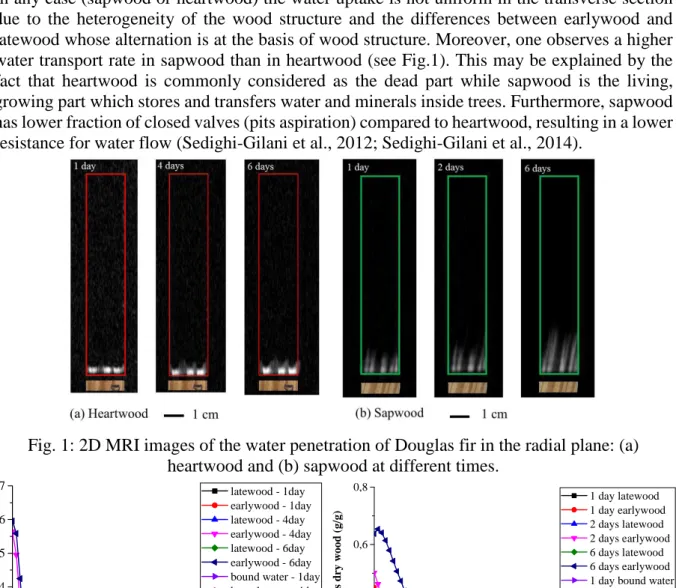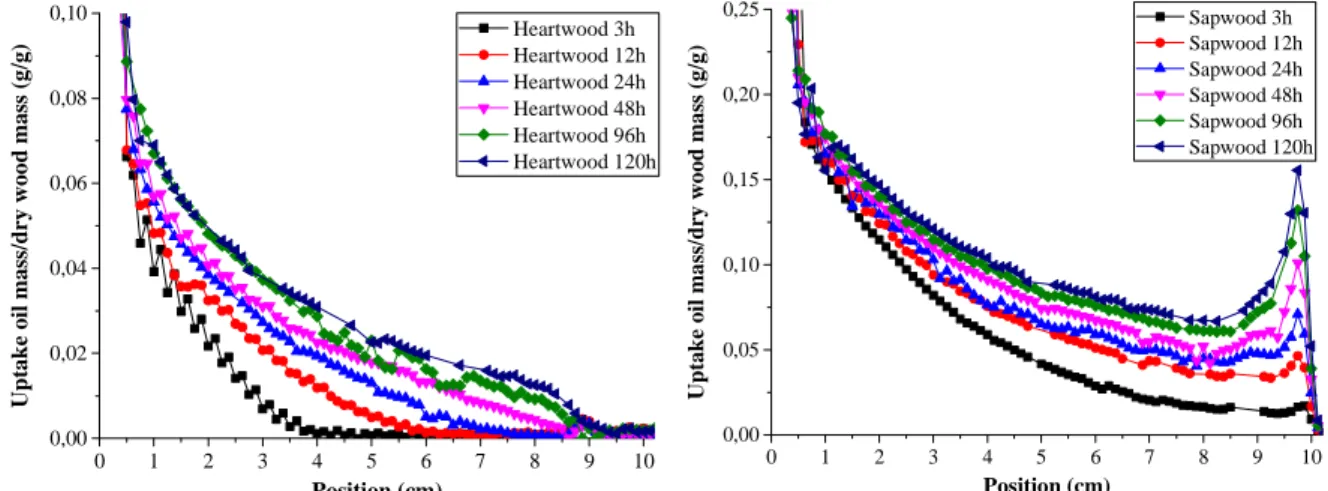HAL Id: hal-01986129
https://hal-enpc.archives-ouvertes.fr/hal-01986129
Submitted on 18 Jan 2019HAL is a multi-disciplinary open access
archive for the deposit and dissemination of sci-entific research documents, whether they are pub-lished or not. The documents may come from teaching and research institutions in France or abroad, or from public or private research centers.
L’archive ouverte pluridisciplinaire HAL, est destinée au dépôt et à la diffusion de documents scientifiques de niveau recherche, publiés ou non, émanant des établissements d’enseignement et de recherche français ou étrangers, des laboratoires publics ou privés.
Dang-Mao Nguyen, Sabine Caré, Denis Courtier-Murias, Philippe Coussot
To cite this version:
Dang-Mao Nguyen, Sabine Caré, Denis Courtier-Murias, Philippe Coussot. Mechanisms of liquid transport in softwood inferred from Magnetic Resonance Imaging. 7èmes journées du GDR 3544 “ Sciences du bois ”, Nov 2018, Cluny, France. 4p. �hal-01986129�
1
Mechanisms of liquid transport in softwood inferred from Magnetic
Resonance Imaging
NGUYEN Dang Mao1, CARE Sabine1, COURTIER-MURIAS Denis1, COUSSOT Philippe1
Laboratoire NAVIER, CNRS, IFSTTAR, ENPC, Champs sur Marne, France sabine.care@ifsttar.fr
Keywords: Douglas-fir; Imbibition; MRI; Oil; Softwood; Sorption; Water. Context, Objectives
Water in wood material plays a major role with regard to its mechanical or physical properties in various situations, in particular in outdoor applications, leading to a possible deterioration in the performance of the wood elements (eg. structural integrity, thermal insulation). Therefore, it is crucial to understand the water uptake and release as well how the water transports in the wood material to extend the lifetime of the timber buildings. The mechanisms of liquid transport are related to the hierarchical and multi-scale structure of wood and to the presence of free and bound water. Despite numerous studies, the water migration process in wood material is not well understood.
For this study, softwood materials used in construction are subjected to imbibition tests. Through an original approach coupling quantitative information obtained from mass and deformation measurements, Nuclear Magnetic Resonance (NMR) and Magnetic Resonance Imaging (MRI) (Bonnet et al., 2017; Gezici-Koc et al., 2017; Van-Meel et al., 2011; Zhou et al., 2018), we are able to quantify bound and free water, which finally allows to better understand imbibition mechanisms. Additional experiments with oil (dodecane) allow to compare the characteristics of water imbibition with those of a liquid not hygroscopically adsorbed in wood.
Materials and methods
The materials are collected from Douglas-fir, either in the outer part of the trunk (sapwood) or the inner part (heartwood). All the samples are taken side by side in order to minimize the variability between them and are sawn along the anisotropic directions of wood. Each sample is initially stored at RH (relative humidity) of 53% at room temperature (20 °C).
Small samples of 1cm3 are pre-conditioned at different humidity levels or are soaked into water or oil. The NMR relaxation technique is used to identify T2 relaxation times of the different
water states in wood (bound and free water) or of oil in wood.
Larger samples (10x4x2 cm3) are prepared for imbibition tests. Four out of six faces are sealed with a liquid impermeable coating along the vertical sides parallel to the imbibition direction in order to avoid edge effects. The bottom open surface of the sample is placed in contact with water or oil, which can then progress along the longitudinal direction. MRI is used to determine water and oil distribution in wood. 2D pictures and 1D distribution profiles of liquid content are obtained by MRI. According to the distribution of the T2 relaxation times, only free water
is detected in our MRI tests, but the two types of free water could be distinguished that can be considered as corresponding to water in earlywood or in latewood. Besides, the content of bound water may be inferred from measurements of the (macroscopic) deformation field during the same tests. The validity of this approach is confirmed by mass measurements, which appear to be consistent with that expected from the sum of free and bound water types.
2
Results and discussion
Water imbibition
In any case (sapwood or heartwood) the water uptake is not uniform in the transverse section due to the heterogeneity of the wood structure and the differences between earlywood and latewood whose alternation is at the basis of wood structure. Moreover, one observes a higher water transport rate in sapwood than in heartwood (see Fig.1). This may be explained by the fact that heartwood is commonly considered as the dead part while sapwood is the living, growing part which stores and transfers water and minerals inside trees. Furthermore, sapwood has lower fraction of closed valves (pits aspiration) compared to heartwood, resulting in a lower resistance for water flow (Sedighi-Gilani et al., 2012; Sedighi-Gilani et al., 2014).
Fig. 1: 2D MRI images of the water penetration of Douglas fir in the radial plane: (a) heartwood and (b) sapwood at different times.
Fig. 2: Water distribution profiles in Douglas-fir, along the longitudinal direction, during imbibition tests, bound water (filled symbols) and free water (cross symbols) for heartwood
(a) after: 1 day (black), 4 days (red) and 6 days (blue); and for sapwood (b) after: 1 day (black), 2 days (red) and 6 days (blue).
Bound water clearly progresses more rapidly than free water in the sample during imbibition tests (see Fig.2). Such an effect was already observed in hardwood, where it was shown that wetting is damped by the liquid sorption in cell walls, so that free water dynamics is governed by the bound water advance (Zhou et al., 2018). However, here the situation may be somewhat
0 1 2 3 4 5 6 7 8 9 10 0,0 0,1 0,2 0,3 0,4 0,5 0,6 0,7 w a te r u p ta k e /m a ss d ry w o o d ( g /g ) Position (cm) latewood - 1day earlywood - 1day latewood - 4day earlywood - 4day latewood - 6day earlywood - 6day bound water - 1day bound water - 4day bound water - 6day
0 1 2 3 4 5 6 7 8 9 10 0,0 0,2 0,4 0,6 0,8 w a te r u p ta k e n /m a ss d ry w o o d ( g /g ) Position (cm) 1 day latewood 1 day earlywood 2 days latewood 2 days earlywood 6 days latewood 6 days earlywood 1 day bound water 2 day bound water 6 day bound water
3 different since it may be observed that in sapwood free water advances much faster than in heartwood. This is consistent with the fact that in heartwood more valves are closed, so that free water cannot progress beyond a first set of open tracheids, except by first being adsorbed as bound water.
Dodecane imbibition
Fig. 3 shows the distribution of the dodecane oil inside the heartwood and sapwood samples from 2D MRI images in a radial plane. It can be observed that, with heartwood, the oil seems to preferentially penetrate in latewood along sample vertical axis (see Fig. 3a). In sapwood, dodecane can penetrate in both earlywood and latewood (see Fig. 3b). The difference in the mechanisms and rate of oil transport in the two types of wood is likely due to the fact that, in heartwood, all bordered pits in earlywood are closed due to the elasticity of their membrane (Sperry and Tyree, 1990).
Fig.3: 2D MRI images of dodecane distribution in the radial plane of heartwood (a) and sapwood (b) at different times.
Fig. 4: Profiles of dodecane oil, along the longitudinal direction, at different times from MRI measurements: (a) heartwood and (b) sapwood
The 1D profiles showing the penetration of the dodecane into heartwood and sapwood as a function of time are plotted in Fig. 4. Dodecane progresses along the sample vertical axis with time. Furthermore, dodecane penetrates more rapidly into sapwood than into heartwood and spreads along the top of the sample. Dodecane content is higher into sapwood in coherence with its location into earlywood and latewood.
0 1 2 3 4 5 6 7 8 9 10 0,00 0,02 0,04 0,06 0,08 0,10 U p ta k e o il m a ss /d ry w o o d m a ss ( g /g ) Position (cm) Heartwood 3h Heartwood 12h Heartwood 24h Heartwood 48h Heartwood 96h Heartwood 120h 0 1 2 3 4 5 6 7 8 9 10 0,00 0,05 0,10 0,15 0,20 0,25 U p ta k e o il m a ss /d ry w o o d m a ss ( g /g ) Position (cm) Sapwood 3h Sapwood 12h Sapwood 24h Sapwood 48h Sapwood 96h Sapwood 120h
4
Conclusion
Our data reveal interesting features concerning the process of water and dodecane imbibition in softwood. It appears to be complex as the liquid transport is influenced both by the complex geometric structure of the wood, with open or closed paths, and by the interaction between bound water adsorption and wetting. Moreover, dodecane penetrates more rapidly than water within the wood due to the interplay of bound water with cell walls. Indeed, the free water progression is governed by the end of the region saturated with bound water.
Acknowledgements
This work has benefited from a French government grant managed by ANR within the frame of the national program Investments for the Future ANR-11-LABX-022-01 (Labex MMCD, http://mmcd.univ-paris-est.fr/).
References
Bonnet M., Courtier-Murias D., Faure P., Rodts S., Care S. (2017) NMR determination of sorption isotherms in earlywood and latewood of Douglas fir. Identification of bound water components related to their local environment. Holzforschung, 71, 481–490.
Gezici-Koc O., Erich S.J.F., Huinink H.P., Ven L.G.J., Adan O.C.G. (2017) Bound and free water distribution in wood during water uptake and drying as measured by 1D magnetic resonance imaging. Cellulose, 24, 535–553.
Sedighi-Gilani M., Griffa M., Mannes D., Lehmann E., Carmeliet J., Derome D. (2012) Visualization and quantification of liquid water transport in softwood by means of neutron radiography. International Journal of Heat and Mass Transfer, 55, 6211–6221.
Sedighi-Gilani M., Vontobel P., Lehmann E., Carmeliet J., Derome D. (2014) Liquid uptake in Scots pine sapwood and hardwood visualized and quantified by neutron radiography. Materials and Structures, 47, 1083–1096.
Sperry J.S., Tyree M.T. (1990) Water stress-induced xylem embolism in three species of conifers. Plant, Cell & Environment, 13, 427-436.
Van-Meel P.A., Erich S.J.F., Huinink H.P., Kopinga K., Jong J.D., Adan O.C.G. (2011) Moisture transport in coated wood. Progress in Organic Coatings, 72, 686– 694.
Zhou M., Caré S., Courtier-Murias D., Faure P., Rodts S., Coussot P. (2018) Magnetic resonance imaging evidences of the impact of water sorption on hardwood capillary imbibition dynamics. Wood Science and Technology, 52, 929–955.

